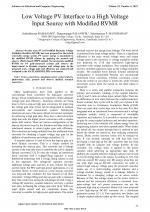| 4/2022 - 3 |
Low Voltage PV Interface to a High Voltage Input Source with Modified RVMRRAMASAMY, S. |
| Extra paper information in |
| Click to see author's profile in |
| Download PDF |
Author keywords
converters, maximum power point trackers, photovoltaic cells, perturb and observe method, resonant converters
References keywords
converter(16), power(15), electronics(13), resonant(12), voltage(11), rectifier(7), applications(6), high(5), energy(5), doubler(5)
Blue keywords are present in both the references section and the paper title.
About this article
Date of Publication: 2022-11-30
Volume 22, Issue 4, Year 2022, On page(s): 23 - 30
ISSN: 1582-7445, e-ISSN: 1844-7600
Digital Object Identifier: 10.4316/AECE.2022.04003
Web of Science Accession Number: 000920289700003
SCOPUS ID: 85149959115
Abstract
In this work PV fed Modified Resonant Voltage Multiplier Rectifier (RVMR) has been proposed for the hybrid renewable energy system. PV source energy is maximized in the modified RVMR scheme by applying the perturb and observe (P&O) based MPPT method. To incorporate modified RVMR for PV grid-connected systems and observe the improvement in dynamic response and voltage gain. In the proposed work, voltage gain and efficiency are analyzed and evaluated in the MATLAB/SIMULINK environment. |
| References | | | Cited By |
Web of Science® Times Cited: 0
View record in Web of Science® [View]
View Related Records® [View]
Updated today
SCOPUS® Times Cited: 2
View record in SCOPUS® [Free preview]
View citations in SCOPUS® [Free preview]
There are no citing papers in the CrossRef Cited-by Linking system.
Disclaimer: All information displayed above was retrieved by using remote connections to respective databases. For the best user experience, we update all data by using background processes, and use caches in order to reduce the load on the servers we retrieve the information from. As we have no control on the availability of the database servers and sometimes the Internet connectivity may be affected, we do not guarantee the information is correct or complete. For the most accurate data, please always consult the database sites directly. Some external links require authentication or an institutional subscription.
Web of Science® is a registered trademark of Clarivate Analytics, Scopus® is a registered trademark of Elsevier B.V., other product names, company names, brand names, trademarks and logos are the property of their respective owners.
Faculty of Electrical Engineering and Computer Science
Stefan cel Mare University of Suceava, Romania
All rights reserved: Advances in Electrical and Computer Engineering is a registered trademark of the Stefan cel Mare University of Suceava. No part of this publication may be reproduced, stored in a retrieval system, photocopied, recorded or archived, without the written permission from the Editor. When authors submit their papers for publication, they agree that the copyright for their article be transferred to the Faculty of Electrical Engineering and Computer Science, Stefan cel Mare University of Suceava, Romania, if and only if the articles are accepted for publication. The copyright covers the exclusive rights to reproduce and distribute the article, including reprints and translations.
Permission for other use: The copyright owner's consent does not extend to copying for general distribution, for promotion, for creating new works, or for resale. Specific written permission must be obtained from the Editor for such copying. Direct linking to files hosted on this website is strictly prohibited.
Disclaimer: Whilst every effort is made by the publishers and editorial board to see that no inaccurate or misleading data, opinions or statements appear in this journal, they wish to make it clear that all information and opinions formulated in the articles, as well as linguistic accuracy, are the sole responsibility of the author.



